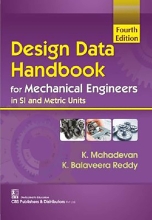Machine design is one of the important subjects in mechanical engineering and a thorough knowledge of the design aspects of machine elements is essential for all design engineers. Working out the design of a machine as a whole, or its components, usually involvesthe use of several formulae, graphs, standard tables and other relevant data.
Availability of all such information in one handbook not only eliminates the unnecessary task ot remembering the required formulae and equations, but also helps design engineers to solve the problems in machine design quickly and efficiently.

